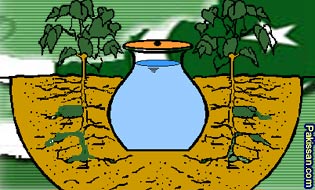
Pitcher irrigation
 A couple of inches of rain
and a lot of melting snow mean that our garden is about as wet as it
gets right now. Still, I was intrigued when I read about pitcher
irrigation. This traditional technique is a bit like drip
irrigation for dummies --- you bury an unglazed ceramic pot in the
soil, fill it with water, and the liquid seeps out into a three to six
foot diameter area, keeping the soil at a constant 80% of
saturation. If the soil gets too wet, water will actually seep
back into the pot, so there's no need to worry about overwatering, and
there is clearly no runoff.
A couple of inches of rain
and a lot of melting snow mean that our garden is about as wet as it
gets right now. Still, I was intrigued when I read about pitcher
irrigation. This traditional technique is a bit like drip
irrigation for dummies --- you bury an unglazed ceramic pot in the
soil, fill it with water, and the liquid seeps out into a three to six
foot diameter area, keeping the soil at a constant 80% of
saturation. If the soil gets too wet, water will actually seep
back into the pot, so there's no need to worry about overwatering, and
there is clearly no runoff.
I've read that 1.5 to
2.5 gallon ceramic pots are ideal, but infonet-biovision suggests using a dried sweet
monkey orange fruit (whatever that is.) Makes me wonder if a
dried gourd would work? I'm very content with our
irrigation method
for the main part of the garden, but would like to have something more
low-tech in my arsenal, especially for watering trees and other
perennials that are spread out across the yard. I can even see
pitcher irrigation being a fun way to keep those potted plants wet
during a dry summer on a hot patio. Has anybody tried it?
Want more in-depth information? Browse through our books.
Or explore more posts by date or by subject.
About us: Anna Hess and Mark Hamilton spent over a decade living self-sufficiently in the mountains of Virginia before moving north to start over from scratch in the foothills of Ohio. They've experimented with permaculture, no-till gardening, trailersteading, home-based microbusinesses and much more, writing about their adventures in both blogs and books.
Want to be notified when new comments are posted on this page? Click on the RSS button after you add a comment to subscribe to the comment feed, or simply check the box beside "email replies to me" while writing your comment.

Roland --- good idea! I guess terracotta pots had a lot going for them (although used by themselves they tend to dry out much faster, which is why I've always used plastic.)
Fostermamas --- good call! I hadn't heard them called that, but looking at the Dervaes family website, it looks like they've got a good cottage business selling irrigation pitchers under that name. For anyone who's interested, you can get them at http://www.peddlerswagon.com/p-19-olla-oy-ya-pumpkin.aspx#reviewLink
I'd be tempted to make my own --- finally dig my old potters wheel out of the barn...
If you want to use a single terracotta pot, use one that is glazed. Those are watertight AFAIK.
Making your own would be a good use of your clay soil, wouldn't it? Firing a kiln with wood seems like a big undertaking though, looking at this.
OTOH, you shouldn't loose to much of your clay, since it is about the most fertile soil you can have (so I've been told). But clay soils tend to have drainage issues. It is an issue here in our "polders" (reclaimed land). Here in the Netherlands there are several solutions practiced;
Just putting sand on top of the clay is not a permanent solution; after a couple of years the sand will have sunk into the clay.
Keep in mind though that if you start draining, the clay will compact and the surface will sink.
In a recent comment on Cosmic Cookout (science of the paranormal article) I left a link to a report about finding potable water. I think it is worth reading to get a better understanding about geohydrology, since drainage is more-or-less the the other side of the coin from finding water.
Among gardening circles, it's generally accepted that sand is a short-term fix to clay soil. Instead, the best solution is copious additions of organic matter, while the best way to deal with waterlogged soil is raised beds. Organic matter sucks up excess water out of the soil, holding onto it until the plants need it in dry weather. And raised beds have the obvious advantage of literally raising you above the groundwater. My hugelkultur beds combine the two techniques, making the swales pretty much irrelevant.
The only areas I'd really need to drain are paths where there's literally water running across the surface of the ground during very wet spells. The goal would be just to channel the water out of the walking area and keep my feet dry. But since that only happens for a few weeks out of the year, I tend to forget about it...
This is a similar idea, but they keep the planting movable, either in buckets, or bags. I hope it stokes the fires of your creativity!
http://www.globalbuckets.org/